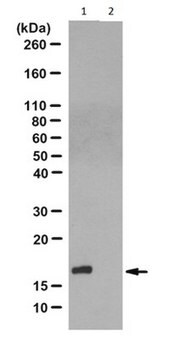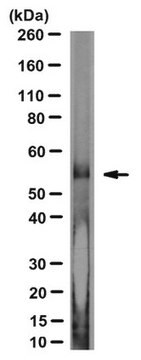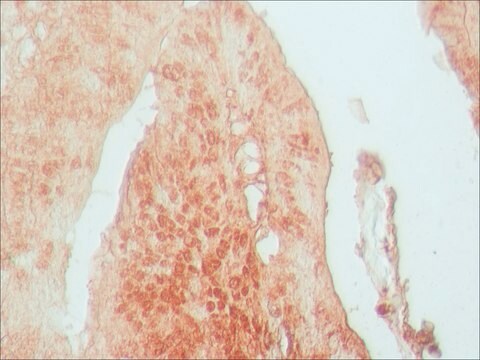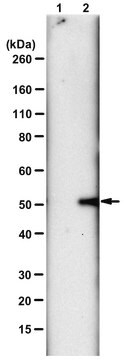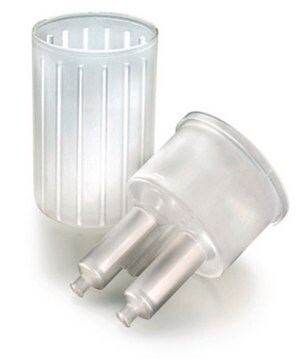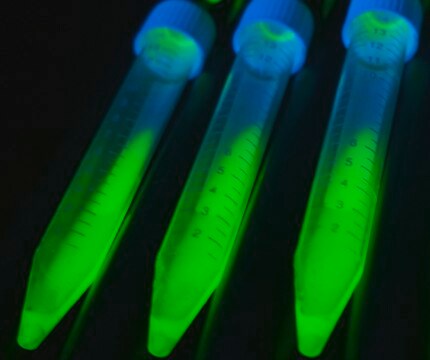ABS1670
Anti-Phosphohistidine (pHis)
from rabbit, purified by affinity chromatography
Sinonimo/i:
pHis, phosphohistidine
About This Item
ELISA
IP
WB
dot blot: suitable
immunoprecipitation (IP): suitable
western blot: suitable
Prodotti consigliati
Origine biologica
rabbit
Livello qualitativo
Forma dell’anticorpo
affinity isolated antibody
Tipo di anticorpo
primary antibodies
Clone
polyclonal
Purificato mediante
affinity chromatography
Reattività contro le specie
all, human, sheep, mouse
tecniche
ELISA: suitable
dot blot: suitable
immunoprecipitation (IP): suitable
western blot: suitable
Condizioni di spedizione
ambient
modifica post-traduzionali bersaglio
phosphorylation (pHis )
Informazioni sul gene
human ... PHPT1(29085)
Descrizione generale
Specificità
Immunogeno
Applicazioni
Western Blotting Analysis: A 1:120 dilution from a representative lot detected proteins with histidine phosphorylation in sheep trachea cytosolic extract and human cell lysates, including 16HBE14o-, HEK293T, THP-1, and THP-1-derived macrophages (Courtesy of Bezaleel Mambwe, Richmond Muimo and RFW Jackson, Department of Infection, Immunity and Cardiovascular Disease/ Department of Chemistry, University of Sheffield, UK).
ELISA Analysis: A representative lot detected pHis- and pPza-, but not pTyr-, pSer-, pThr-, conjugated BSA or unconjugated BSA (Lilley, M., et al. (2015). Chem. Commun. (Camb). 51(34):7305-7308).
Immunoprecipitation Analysis: A representative lot immunoprecipitated proteins with histidine phosphorylation from ovine airway epithelia extract (Lilley, M., et al. (2015). Chem. Commun. (Camb). 51(34):7305-7308).
Western Blotting Analysis: A representative lot detected histidine phosphorylated proteins in 16HBE14o- human bronchial epithelial cell lysate and in ovine airway epithelia extract. Acid (0.1 M HCl or 0.4 M acetic acid/0.1 M hydroxylamine), but not alkaline (0.1 M NaOH), treatment of the lysates abolished targets bands detection (Lilley, M., et al. (2015). Chem. Commun. (Camb). 51(34):7305-7308).
Western Blotting Analysis: A representative lot detected histidine phosphorylation of immunoprecipitated NDPK-A/B from ovine airway epithelia extract, as well as G -R/M from 16HBE14o- human bronchial epithelial cell lysate (Lilley, M., et al. (2015). Chem. Commun. (Camb). 51(34):7305-7308).
Note: DO NOT HEAT SAMPLES prior to phosphohistidine detection. Histidine phosphorylation is heat and acid labile. To generate negative control for specificity test, an aliquot of sample can be heated at 95ºC for 10-15 minutes to reverse histidine phosphorylation. Alternatively, an aliquot of sample can be incubated under acidified pH at 37ºC for 15 minunites to reduce histidine phosphorylation. Acidify each 100 µL sample with 25 µL of 1 M HCl before the incubation, then neutralize with 25 µL of 1 M NaOH prior to phosphohistidine detection.
Signaling
Qualità
Western Blotting Analysis: A 1:200 dilution of this antibody detected histidine-phosphorylated proteins in 10 µg of HEK293 cell lysate.
Descrizione del bersaglio
Stato fisico
Stoccaggio e stabilità
Altre note
Esclusione di responsabilità
Non trovi il prodotto giusto?
Prova il nostro Motore di ricerca dei prodotti.
Codice della classe di stoccaggio
12 - Non Combustible Liquids
Classe di pericolosità dell'acqua (WGK)
WGK 1
Punto d’infiammabilità (°F)
Not applicable
Punto d’infiammabilità (°C)
Not applicable
Certificati d'analisi (COA)
Cerca il Certificati d'analisi (COA) digitando il numero di lotto/batch corrispondente. I numeri di lotto o di batch sono stampati sull'etichetta dei prodotti dopo la parola ‘Lotto’ o ‘Batch’.
Possiedi già questo prodotto?
I documenti relativi ai prodotti acquistati recentemente sono disponibili nell’Archivio dei documenti.
Il team dei nostri ricercatori vanta grande esperienza in tutte le aree della ricerca quali Life Science, scienza dei materiali, sintesi chimica, cromatografia, discipline analitiche, ecc..
Contatta l'Assistenza Tecnica.